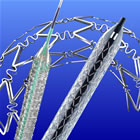 At this week’s annual European Society of Cardiology Congress in Rome, an important randomized clinical trial on stents was presented by Professor Kaare H. Bønaa, MD, PhD of the Clinic for Heart Disease, St. Olav’s University Hospital in Trondheim, Norway. Called NORSTENT, short for the “Norwegian Coronary Stent Trial,” this was the largest stent trial ever conducted, with 9,013 patients followed for six years. That’s serious! Continue reading
At this week’s annual European Society of Cardiology Congress in Rome, an important randomized clinical trial on stents was presented by Professor Kaare H. Bønaa, MD, PhD of the Clinic for Heart Disease, St. Olav’s University Hospital in Trondheim, Norway. Called NORSTENT, short for the “Norwegian Coronary Stent Trial,” this was the largest stent trial ever conducted, with 9,013 patients followed for six years. That’s serious! Continue reading
Category Archives: Cost Effectiveness
Philips Buys Volcano: It’s About Money, Technology, and History
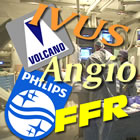 Rumors and theories about an acquisition of Volcano Corporation (NASDAQ: VOLC) had been circulating for quite some time: months, years even. The company seemed an obvious choice: it has an advanced intravascular ultrasound (IVUS) technology that leads the market, with Boston Scientific coming in second; it has a fractional flow reserve (FFR) wire that splits the market with St. Jude Medical; and recently Volcano gained FDA approval for its Instant Wave-Free Ratio (iFR) physiologic measurement product, a faster, cheaper potential alternative to FFR. Continue reading
Rumors and theories about an acquisition of Volcano Corporation (NASDAQ: VOLC) had been circulating for quite some time: months, years even. The company seemed an obvious choice: it has an advanced intravascular ultrasound (IVUS) technology that leads the market, with Boston Scientific coming in second; it has a fractional flow reserve (FFR) wire that splits the market with St. Jude Medical; and recently Volcano gained FDA approval for its Instant Wave-Free Ratio (iFR) physiologic measurement product, a faster, cheaper potential alternative to FFR. Continue reading
Fractional Flow Reserve: Measuring Pressures in the Marketplace
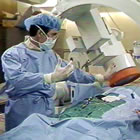
Dr. Andreas Gruentzig
“I don’t know how anyone can do these procedures without measuring pressures!”
That’s what Andreas Gruentzig, the father of coronary angioplasty, said to me back in 1985. He knew that looking at the angiogram alone was not sufficient for judging the blockage in an artery. Integral to the design of his technological breakthrough, the double-lumen angioplasty balloon, was a feature which allowed him to measure the blood pressure at either end of the arterial blockage. At the start of the procedure, he could quantify how significant the blockage was; when he was done inflating the balloon, he could see the benefit of the dilatation. The post-angiogram might look good, but the pressures sometimes signaled that blood flow through the area was not. So, inflate again. And maybe again. OK, pressure now looks good, we’re done! Pretty simple. Not brain surgery. Continue reading
Filed under Business & Industry, Cost Effectiveness, FAME I / FAME II, FFR, History, Stent
Will a Denial of Service DOS Attack Hit New York State Medicaid Patients? Or Perhaps Your State?
 What does a Denial of Service Attack have to do with stents, angioplasty and PCI?
What does a Denial of Service Attack have to do with stents, angioplasty and PCI?
In the world of computing, a DOS attack is defined as “an attempt to make a machine or network resource unavailable to its intended users.” Typically netbots programmed by hackers overwhelm the web servers of banks, credit card providers, etc. whose sites then become unavailable to their customers. Now it seems similarly that in New York State, cardiovascular treatments may become unavailable to some Medicaid patients: a denial of service. Continue reading
Past, Present & Future of Transradial Angioplasty with Dr. Ferdinand Kiemeneij
 On the occasion of the 20th anniversary of transradial intervention (TRI), I talked with Dr. Ferdinand Kiemeneij, “the father of transradial intervention” who practices interventional cardiology at Onze Lieve Vrouwe Gasthuis (OLVG), Amsterdam, The Netherlands.
On the occasion of the 20th anniversary of transradial intervention (TRI), I talked with Dr. Ferdinand Kiemeneij, “the father of transradial intervention” who practices interventional cardiology at Onze Lieve Vrouwe Gasthuis (OLVG), Amsterdam, The Netherlands.
We covered a wide range of topics regarding TRI, where angioplasty and stents are placed via the wrist, and we’ve just posted the two-part interview on Angioplasty.Org. Continue reading
Become Part of the Transradial Angioplasty Surge
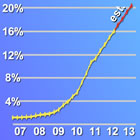
Growth of radial access in U.S. since 2007, estimated to be 20% by end of 2013 (click for larger image)
This graphic shows the adoption curve for the transradial wrist approach to percutaneous coronary interventions (PCI) in the United States from 2007-2012. From 1.2% to 16.1% in just five years. And we estimate that by the end of 2013, TRI will account for 20% of all PCIs. That’s one in five. Pretty impressive. When was the last time a medical procedure that is less expensive, more comfortable for patients and has fewer complications, grew this quickly?
You can read more in our article, “Wrist Angioplasty Sees Unprecedented Growth in U.S.,” which reports on an important study which was published in this week’s Circulation.
Or you can do something about it and become part of this revolution by getting into the training loop. Continue reading
European Society of Cardiology: “Transradial Access Should Be 1st Choice for Angioplasty”
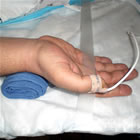 This is very big news.
This is very big news.
Today the European Association of Percutaneous Cardiovascular Interventions (EAPCI), the Acute Cardiovascular Care Association (ACCA) and the Working Group (WG) on Thrombosis of the European Society of Cardiology (ESC) published their joint consensus document on the radial approach to PCI, online ahead of print in EuroIntervention. Continue reading



